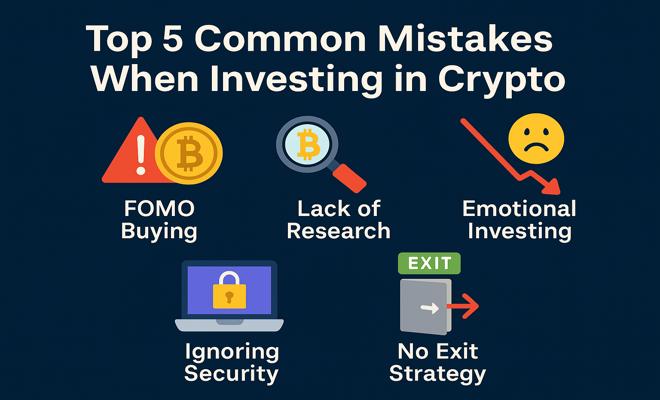
Top 5 Common Mistakes Beginners Make When Investing in Crypto
1. 🤯 FOMO Investing (Fear of Missing Out)
FOMO is the emotional impulse to buy a coin simply because “everyone else is doing it.” Social media hype, influencer endorsements, or sudden price spikes can trigger irrational decision-making.
📉 Why it's dangerous: You end up buying at the peak, only to watch your investment plummet shortly after. Projects with no fundamentals can quickly crash after the hype fades.
✅ How to avoid it:
- Conduct independent research before buying.
- Use technical and fundamental analysis.
- Ignore short-term trends and focus on long-term value.
- Ask: “Would I buy this coin even if no one else was talking about it?”
2. 📉 Investing Without Understanding the Project
Buying a coin without knowing its purpose is like gambling. Many beginners can’t explain what the token does or what problem it solves — that’s a red flag.
⚠️ Risks include:
- Falling for scam coins or rug pulls.
- Investing in projects with no real use case or future.
✅ How to avoid it:
- Read the whitepaper (yes, really!).
- Check the project’s website, roadmap, and team credibility.
- Understand how the token generates utility (staking, governance, rewards, etc.).
- Compare competitors to gauge real-world demand.
3. 😬 Letting Emotions Drive Decisions
Markets are volatile — and that volatility triggers strong emotions. Beginners often sell in panic during dips or FOMO-buy during spikes, sabotaging their portfolio.
💥 Common emotional traps:
- Panic-selling during short-term corrections.
- Overconfidence after a few lucky gains.
- Revenge-trading after a loss.
✅ How to avoid it:
- Create a written investment plan — and stick to it.
- Use stop-loss and take-profit orders.
- Allocate only what you can afford to lose.
- Avoid making decisions during high emotional states.
4. 🔐 Ignoring Security Best Practices
With over $10 billion lost in crypto hacks and scams, ignoring basic security can be catastrophic. Beginners often leave assets on exchanges or fall for phishing links.
⚠️ Security threats include:
- Fake apps or websites.
- Malicious airdrops or DMs.
- Exchange hacks or bankruptcies (e.g., FTX).
✅ How to stay secure:
- Use a hardware wallet (like Ledger or Trezor) for long-term storage.
- Enable 2FA (two-factor authentication) on all accounts.
- NEVER share your seed phrase or private keys.
- Bookmark official websites — don’t trust search ads.
- Avoid storing large amounts on centralized exchanges.
5. 🚪 Not Having an Exit Strategy
Knowing when to exit is just as important as knowing when to enter. Many new investors ride the wave up… and then all the way back down.
🌀 Without a plan, you might:
- Miss profit-taking opportunities.
- Hold through bear markets without rebalancing.
- Panic-sell after unrealized gains vanish.
✅ How to build an exit strategy:
- Set clear goals (e.g., take profits at +100%, +200%).
- Use Dollar-Cost Averaging (DCA) when exiting — not just when buying.
- Diversify your portfolio and rebalance based on performance.
- Consider using stablecoins to lock profits.
🧠 Final Thoughts: Invest Smart, Not Fast
Crypto is a powerful tool — but like all tools, it requires skill. By avoiding these common mistakes and adopting a disciplined, informed approach, you’ll dramatically increase your chances of success in this fast-moving space.
📚 Want more guidance?
At BitMedia24, we provide beginner-friendly crypto education, expert price predictions, and trusted news to help you navigate the decentralized future.
🚀 Stay ahead of the curve. Stay secure. And most importantly — stay smart.